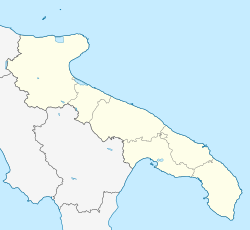Top Qs
Timeline
Chat
Perspective
Bari Karol Wojtyła Airport
International airport serving Bari, Italy From Wikipedia, the free encyclopedia
Remove ads
Bari Karol Wojtyła Airport (Italian: Aeroporto di Bari-Karol Wojtyła) (IATA: BRI, ICAO: LIBD) is an airport serving the city of Bari in Italy. It is approximately 8 km (5 mi) northwest from the town centre. Named after Pope John Paul II, who was born Karol Wojtyła, the airport is also known as Palese Airport (Italian: Aeroporto di Palese) after a nearby neighbourhood. The airport handled 6,461,179 passengers in 2023.[2]
Remove ads
Remove ads
History
Summarize
Perspective
Early years
The airport of Bari was originally a military airfield, built in the 1930s, by the Regia Aeronautica. During World War II Italian Campaign, it was seized by the British Eighth Army in late September 1943, and turned into an Allied military airfield. Until the end of the war in May 1945, it was used by the Royal Air Force and the United States Army Air Forces Twelfth and Fifteenth Air Forces both as an operational airfield as well as a command and control base. In addition, the airfield was used by the Italian Co-Belligerent Air Force (Aviazione Cobelligerante Italiana, or ACI), or Air Force of the South (Aeronautica del Sud), and the Balkan Air Force. After the war, it was turned over to the postwar Air Force of the Italian Republic (Aeronautica Militare Italiana).
In the 1960s, it was opened to civil flights and Alitalia schedules regular flights to Rome, Catania, Palermo, Ancona, Venice. The routes were later taken over by ATI, using a Fokker F27 airplane. When ATI put into operation the new DC-9-30 it became necessary to create a new runway, while the military complex was still used as passenger terminal.
In 1981, a new building was completed, originally intended to be used as a cargo terminal, but it became in fact the airport's new passenger terminal.
Development since the 1990s
In 1990, with the 1990 FIFA World Cup, the runway was extended and the terminal was upgraded, going through a further renovation in 2000. However, the traffic increase showed the infrastructural limitations of the airport and in 2002 the founding stone of the new passenger terminal was laid out. At the same time, flight infrastructures (aircraft parking areas, runway etc.) were upgraded. In 2005, the new terminal was completed and opened to passengers.[citation needed]
In 2005, construction works for a new control tower began and they were completed the following year. In 2006, a further extension of the runway was begun, and in 2007, the planning of an extension of the passenger terminals was commissioned. They were upgraded in 2005–2006 with the opening of a new passenger terminal equipped with four jet bridges and a multistorey car park.[citation needed]
Remove ads
Airlines and destinations
Summarize
Perspective
The following airlines operate regular scheduled, seasonal, and charter flights to and from Bari:[3]
Remove ads
Statistics


Graphs are unavailable due to technical issues. Updates on reimplementing the Graph extension, which will be known as the Chart extension, can be found on Phabricator and on MediaWiki.org. |
Annual passenger traffic at BRI airport.
See Wikidata query.
Ground transportation
Road
The airport can be reached by the ring road of Bari and from the A14 motorway.
Rail
The Bari metropolitan railway service connects the airport with the Bari Centrale railway station in the city centre.
Bus
AMTAB buses provide public transportation to the airport from the city centre (Line 16). Pugliairbus is a seasonal bus transportation service which operates interconnection service with Brindisi and Foggia airports. Pugliairbus also reaches touristic locations.
Tempesta auto servizi[58] also offers a shuttle between the airport and city centre.
Remove ads
Accidents and incidents
On 6 August 2005, Tuninter Flight 1153, a Tuninter ATR 72, en route from Bari to Djerba, Tunisia, ditched into the Mediterranean Sea about 18 miles (29 km) from the city of Palermo. 16 of the 39 people on board died. The accident resulted from engine fuel starvation. During maintenance the fuel quantity indicator (FQI) was changed using an FQI for an ATR 42 instead of an ATR 72.[59]
See also
References
External links
Wikiwand - on
Seamless Wikipedia browsing. On steroids.
Remove ads




